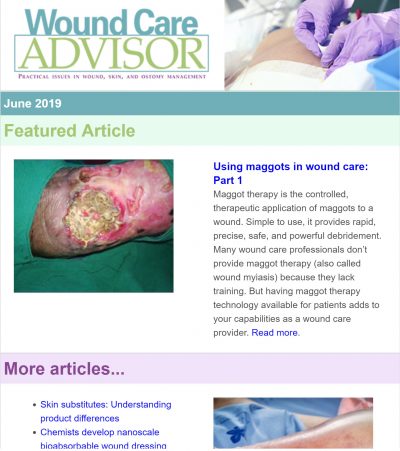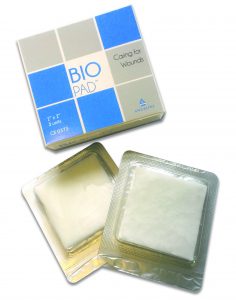Stay Updated!
Get access to original and peer-reviewed clinical content dealing with chronic wounds and ostomy management issues. Monthly frequency. Sign up for the Wound Care Advisor email newsletter today!

More results...
Optimizing nutritional status is a key strategy both in preventing and managing pressure ulcers. In patients across all care settings, compromised nutrition— as from poor intake, undesired weight loss, and malnutrition—increases the risk of pressure ulcers. It contributes to altered immune function, impaired collagen synthesis, and decreased tensile strength. In many cases, malnutrition also contributes to wound chronicity and increases the risk for delayed and impaired wound healing. In patients with chronic wounds, such as pressure ulcers, a chronic inflammatory state can induce catabolic metabolism, malnutrition, and dehydration. (more…)
Read MoreDiabetic foot ulcers stem from multiple factors, including peripheral neuropathy, high plantar pressures, decreased vascularity, and impaired wound healing. Contributing significantly to morbidity, they may cause limb loss and death. (See Foot ulcers and diabetes.)
Initially, hydrocolloid dressings were developed to function as part of the stomal flange. Based on their success in protecting peristomal skin, they were introduced gradually into other areas of wound care. They contain wafers of gel-forming polymers, such as gelatin, pectin, and cellulose agents, within a flexible water-resistant outer layer. The wafers absorb wound exudate, forming a gel and creating a moist healing environment. (more…)
Read MoreWe all lead busy lives, with demanding work schedules and home responsibilities that can thwart our best intentions. Although we know it’s our responsibility to stay abreast of changes in our field, we may feel overwhelmed when we try to make that happen.
Keeping clinicians up-to-date on clinical knowledge is one of the main goals of the Wild On Wounds (WOW) conference, held each September in Las Vegas. Each year, I present the opening session of this conference, called “The Buzz Report,” which focuses on the latest-breaking wound care news—what’s new, what’s now, what’s coming up. I discuss innovative new products, practice guidelines, resources, and tools from the last 12 months in skin, wound, and ostomy management. This article highlights the hottest topics from my 2015 Buzz Report. (more…)
Read More
At the 2015 Wild on Wounds conference, the interactive workshop “Are You Ready for an Outpatient Reimbursement Challenge?” featured a lively discussion among participants about 25 real-life reimbursement scenarios. Here are the top 10 questions the attendees asked, with the answers I provided.
Q Why is it necessary for qualified healthcare professionals (QHPs) such as physicians, podiatrists, nurse practitioners, physician assistants, and clinical nurse specialists to identify the place of service where they provide wound care services and to correctly state the place of service on their claim forms? (more…)
Read MoreBy Gail R. Hebert, MS, RN CWCN, DWC, WCC, OMS
How would you react if you heard a 600-lb patient was being admitted to your unit? Some healthcare professionals would feel anxious—perhaps because they’ve heard bariatric patients are challenging to care for, or they feel unprepared to provide their care. (more…)
Read MoreBy Cheryl Robillard, PT, WCC, CLT, DWC
Patients in your clinical practice who develop wounds should prompt a call for “all hands on deck” to manage the situation, but some personnel may be missing the boat. Physical therapists (PTs), occupational therapists (OTs), and speech-language pathologists (SLPs) should be on board your wound care ship so patients can receive care they need. But unfortunately, sometimes they aren’t. (more…)
Read MoreBy: Donna Sardina, RN, MHA, WCC, CWCMS
What do the Los Angeles Lakers, Green Bay Packers, Montreal Canadiens, and New York Yankees have in common? All three have “three-peated”, meaning they have won three consecutive championships. This year, we at Wound Care Advisor, the official journal of the National Alliance of Wound Care and Ostomy (NAWCO), mark our own three-peat—our third annual “Best of the Best” issue. (more…)
Read MoreDiabetic socks with mild compression can reduce lower extremity edema in patients with diabetes without adversely affecting arterial circulation, according to a randomized control trial presented at the American Diabetes Association 75th Scientific Sessions Conference. (more…)
Read More
BIOPAD: 100% equine Type-1 collagen primary wound dressing
EXSEPT PLUS: electrolytically-produced Sodium Hypochlorite wound cleanser
SILVERSTREAM: Ionic Silver wound cleanser with menthol
ANIOSGEL 85 NPC: HYDROALCOHOLIC ANTISEPTIC GEL for skin and hands BLEACH WIPES 1: 10/1:50 : ready-to-use bleach wipes for surfaces disinfection
Angelini Pharma Inc. has one of the highest quality and most comprehensive product ranges in the chronic wound, infection control and dialysis healthcare market. Our mission is to meet our customers’ day-to-day needs with effective, reliable and high-quality products that are widely available and accessible. This goal is expressed through a clear vision: to be the physician’s first choice of product for their patients’ needs and well being. As a result of our specialists’ expertise and intensive applied research activities, efficient and closely coordinated manufacturing and distribution chain and marketing experience, Angelini Pharma Inc. has achieved excellence in our core business areas including wound care.
For more information, visit Angelini-US.com for more information.
Hy-Tape International produces waterproof, zinc oxide-based adhesive tape. Patches and strips. Hy-Tape delivers its unique qualities and benefits in both critical care and everyday situations, when it counts most.
For more information, call 1.800.248.0101 or visit http://hytape.com.
Amerx Health Care is proud to introduce Helix3 Bioactive Collagen Matrix (CM) and Particle (CP) dressings containing 100% Type 1 native bovine collagen for effective wound management in all wound phases.
The Amerx product line also includes top rated AmeriGel Hydrogel Wound Dressing with Oakin® for sustained moist healing of dry wounds.
For more information, visit www.amerxHC.com or call 800-448-9599.
Coloplast develops products and services that make life easier for people with very personal and private medical conditions. Our business includes ostomy care, urology, continence care, and wound & skin care.
For more information, visit www.coloplast.us or call 800-788-0293
Combining unmatched clinical evidence with the comfort, convenience and variety that today’s healthcare marketplace demands, Heelift offloading boots prevent and treat heel pressure ulcers like no other. Joining the Heelift lineup this year is the new Heelift Glide Ultra and Heelift AFO Ultra, which have a new Ultra-Grip inner lining that provides our most comfortable boot ever while maintaining clinical superiority. Clinician Validated – Cost Performer.
Visit our Resource Center at http://www.heelift.com/heeliftresources.html for videos, sample protocols, clinical articles and more showing how Heelift Boots can lower your prevalence.
Read More